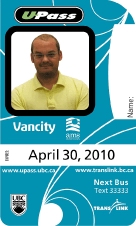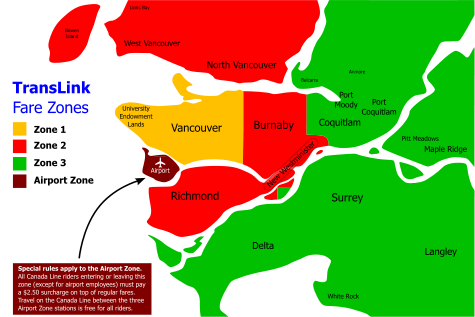.gif)
U-Pass (Vancouver)
Encyclopedia

British Columbia
British Columbia is the westernmost of Canada's provinces and is known for its natural beauty, as reflected in its Latin motto, Splendor sine occasu . Its name was chosen by Queen Victoria in 1858...
.
The original concept of a regional-wide initiative was expanded province-wide in June, 2010 when the provincial government created the U-Pass BC program that offers standardized transit program for all public post-secondary students beginning of September, 2010.
The Lower Mainland program is currently available to Justice Institute of British Columbia
Justice Institute of British Columbia
The Justice Institute of British Columbia is a public, post-secondary educational institution in New Westminster, British Columbia, Canada, that is focused on training professionals in the justice, public safety and social services fields...
, Nicola Valley Institute of Technology
Nicola Valley Institute of Technology
Nicola Valley Institute of Technology British Columbia’s Aboriginal public post-secondary institute in Merritt, British Columbia, that was started in 1983.-History:...
, British Columbia Institute of Technology
British Columbia Institute of Technology
The British Columbia Institute of Technology , is a public, coeducational, academic institution of higher education in Burnaby, British Columbia, Canada. The polytechnic has five campuses located in the Metro Vancouver region, with the main campus in Burnaby...
, Douglas College
Douglas College
Established in 1970, Douglas College is one of the largest public colleges in British Columbia, Canada serving 14,000 credit students, 9,000 continuing education students and 1,000 international students each year.-Programs:...
, Vancouver Community College
Vancouver Community College
Vancouver Community College is a public post-secondary institution in Vancouver, British Columbia, Canada. Founded in 1965, it is the largest and oldest community college in British Columbia, with over 140 certificate and diploma programs...
, Emily Carr University of Art and Design, Kwantlen Polytechnic University
Kwantlen Polytechnic University
Kwantlen Polytechnic University is a public degree-granting undergraduate polytechnic university with four campuses located in the South Fraser region of British Columbia’s Lower Mainland...
, Capilano University, Langara College
Langara College
Langara College is a public degree-granting college in Vancouver, British Columbia, Canada which serves approximately 20,000 students annually through its university, career, and continuing studies programs...
, SFU
Simon Fraser University
Simon Fraser University is a Canadian public research university in British Columbia with its main campus on Burnaby Mountain in Burnaby, and satellite campuses in Vancouver and Surrey. The main campus in Burnaby, located from downtown Vancouver, was established in 1965 and has more than 34,000...
, and UBC
University of British Columbia
The University of British Columbia is a public research university. UBC’s two main campuses are situated in Vancouver and in Kelowna in the Okanagan Valley...
students only, though other post-secondary institutions are eligible to join the program.
Pass holders is eligible to use HandyDART
HandyDART
HandyDART is an accessible transit service in British Columbia that uses vans or small buses to transport disabled or elderly passengers who cannot use the normal transit system...
if requirements are met and also for discounted fare on the West Coast Express
West Coast Express
West Coast Express is the interregional commuter railway in British Columbia, Canada. Opened in 1995, it links Mission, Maple Ridge, Pitt Meadows, Port Coquitlam, Coquitlam, and Port Moody with Waterfront Station in Downtown Vancouver, where it interchanges with SkyTrain rapid transit, SeaBus and...
.
History
The U-Pass program in the Metro Vancouver region was first implemented in September 2003 by TransLink, with the sponsorship of VancityVancity
Vancouver City Savings Credit Union, commonly referred to as Vancity, is a member-owned financial institution in Vancouver, British Columbia and the largest English-speaking credit union in Canada...
. It was first implemented at UBC
University of British Columbia
The University of British Columbia is a public research university. UBC’s two main campuses are situated in Vancouver and in Kelowna in the Okanagan Valley...
and SFU
Simon Fraser University
Simon Fraser University is a Canadian public research university in British Columbia with its main campus on Burnaby Mountain in Burnaby, and satellite campuses in Vancouver and Surrey. The main campus in Burnaby, located from downtown Vancouver, was established in 1965 and has more than 34,000...
but was further expanded to Capilano University and Langara College
Langara College
Langara College is a public degree-granting college in Vancouver, British Columbia, Canada which serves approximately 20,000 students annually through its university, career, and continuing studies programs...
in 2009.
On June 9 2010, the Province
Executive Council of British Columbia
The Executive Council of British Columbia is the cabinet of that Canadian province....
announced that U-Pass program would be expanded into a province-wide initiative at a rate of $30 per month. At the same time, it was announced that VanCity would no longer be a sponsor for the program.
On September 1, 2011, UPass BC program officially launched at 11 public post-secondary institutions.
Fee

Beginning on April 1, 2013, the U-Pass monthly fee will increase to $35 per month.
Fees are paid along with tuition and student fees, and all students (regardless of whether they are taking classes on campus, taking distant education courses, or even on Co-op term) are obliged to purchase the pass, though in some circumstances students may opt out.
U-Passes are non-transferrable. Fraudulent use may result in criminal charges. Students are required to carry supplemental identification when using the U-Pass.
Popularity
According to the UBC U-Pass site, since the UBC U-Pass was implemented, transit ridership now accounts for 42% of all trips to UBC, a figure which is expected to grow by ten percent per year. In a referendum at UBC, the students voted 92% in favour of continuing the program. According to the U-Pass Final Review, Transit ridership at UBC has increased by 63% since the implementation of the U-Pass, 37% of UBC students reported that they have been able to avoid buying a car as a result of the U-Pass and 69% have been able to reduce their reliance on a car due to the pass.According to the SFU U-Pass site, in a referendum held at SFU in March 2005, students voted 83% in favour of continuing the U-Pass program until at least September 2008, and 88% of SFU students currently use a U-Pass. Transit ridership to SFU's
Simon Fraser University
Simon Fraser University is a Canadian public research university in British Columbia with its main campus on Burnaby Mountain in Burnaby, and satellite campuses in Vancouver and Surrey. The main campus in Burnaby, located from downtown Vancouver, was established in 1965 and has more than 34,000...
Burnaby Campus has increased 48% since the launch of the U-Pass program. In addition, one third of SFU students reported that they avoided the need to purchase a vehicle and over 60% reported a reduced reliance on automobiles since the introduction of the Pass.
Environmental Benefits
According to the U-Pass Review Final Report, Translink has estimated that by May 2005, regional green house gas emissions had been reduced by 1,000 tonnes as a result of the SFU U-Pass program and 15,000 tonnes as a result of the UBC U-Pass program. According to the UBC site, current estimates put the U-Pass benefits at a greenhouse gas emissions savings of over 16,000 tonnes per year.Initial implementation
The initial introduction of the U-Pass was met with resistance from some students who drive or ride bicycleBicycle
A bicycle, also known as a bike, pushbike or cycle, is a human-powered, pedal-driven, single-track vehicle, having two wheels attached to a frame, one behind the other. A person who rides a bicycle is called a cyclist, or bicyclist....
s to campus as their primary method of transportation, whether because they live a significant distance from campus, or for other reasons, or who live on campus and rarely use the bus. Some students argued that it was unfair that they had to subsidise the U-Pass programme for other students, despite rarely themselves using the public transportation system. A counter argument was that students would only have to make 10 trips by bus per month to break even on the program.
Students also complained of long lines at Pass-distribution locations at the start of term. This problem was solved by switching to the current system of mailing the passes shortly before the start of term. In 2011, this system has been cancelled due to an increase of fraudulent uses of Upasses. U passes are now referred to the distribution system during office hours causing long lineups and discriminates against Coop students who work off campus coming to the campus to see the distribution machine closed.
The introduction of the programme also resulted in significant crowding on buses heading towards the UBC and SFU campuses, and many students complained that already overcrowded buses were failing to stop to pick them up. This was a particular problem for riders who board the bus closer to campus. TransLink responded by adding more buses and increasing the number and frequency of trips, as well as by introducing new routes. Overcrowding has remained a problem on some routes and at certain times of day.
Ongoing issues

99 B-Line
The 99 B-Line is a bus rapid transit line in Metro Vancouver, British Columbia, Canada. It travels along Broadway, a major east-west thoroughfare, and connects the University of British Columbia to Commercial–Broadway Station on the SkyTrain system...
and the #145 for passengers with valid pre-paid fares (such as U-Pass and monthly passes). Many passengers initially complained that the system was poorly implemented, and that drivers sometimes failed to allow all-door boarding, even at approved stops, or forgot or refused to open the rear doors, resulting in passengers being unable to board, or being unable to find a seat, despite having been at the front of the line. It has also been argued that the occasional visual inspections of U-Passes at the rear doors (at the Broadway and Commercial terminus, for example) simply slows down the boarding process, since it is impossible to tell, just by looking at a U-Pass, whether the individual card is still valid (unless it is past the expiration date printed on the front).
In September 2005, it was discovered that there was a problem that caused all U-Passes to be read as invalid by Translink fareboxes. This was an issue with the fareboxes and new cards were issued in January 2006, and students were permitted to simply show the old cards in the meantime. This has resulted in a large number of drivers continuing to allow U-Pass holders to simply show their card when boarding a bus, without inserting it into the farebox. There have been complaints from students about this.
The introduction of the new Upass has made it impossible for students from SFU on coop semesters to acquire one as the machines dispensing them are off limits after office hours, by the time students are off coop work, the offices would be closed.
Off Campus Parking
There have been complaints that some students who normally drive to campus have taken advantage of the requirement to purchase a U-Pass by driving partway, parking in nearby residential areas, and taking a bus the rest of the way in order to avoid paying parking fees on campus.External links
.

